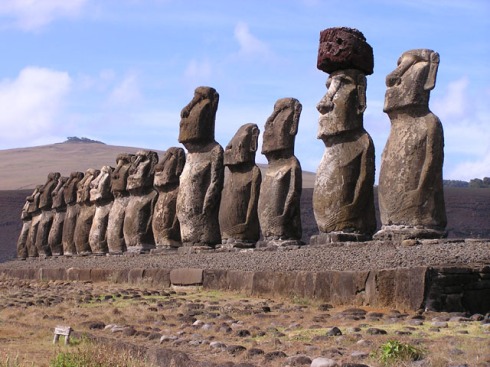The island known to most as Easter Island, which lies 3,200km off the west coast of Chile, is officially named Rapa Nui along with the Polynesian people that live there and the language they speak. Sixty per cent of Easter Island’s 4,000 population are descended from the indigenous group. Most of their income is gained from tourism as people travel to the Unesco World Heritage Site to see the Moais, giant carved stone figures which date from sometime between 1250 and 1500. The Rapa Nui have lobbied the Chilean government for independence since the island was annexed in 1888. And in recent years the struggle has grown more pronounced.

The Maois
On Sunday the most recent clash saw police evict a group of Rapa Nui, the Hitorangi clan, from a luxury hotel which they had been occupying since August in protest. They claim the hotel was built on land which had been illegally seized from their ancestors. For months they have been protesting against plans to develop the island for further tourism. The Hangaroa Eco Village and Spa where the group were camped out was brought from the Chilean government by the Scheiss family, a powerful investment group, in the 1990s. Hotel owner Jeannette Scheiss was quoted in the Santiago Times saying: “If someone feels they have a claim to our land, they have to prove it through judicial procedures”. Rodrigo Gomez, a lawyer for the group, said up to 50 armed police had broken into the hotel to remove the final five occupiers who were arrested and released pending court hearings. Mr Gomez said the operation, which took place two days before the group were due to appear in court to discuss the land ownership, had been “utterly irregular and illegal”. A statement on the Save Rapa Nui website claimed that another of the group’s lawyers had been prevented from visiting his clients in jail. Continue reading →
Tags: Chile, Easter Island, Hangaroa, Hitorangi, James Anaya, Moais, Rapa Nui, Rodrigo Gomez, Scheiss, Sebastian Pinera







Backpacking in Chile- The Top 5 Highlights
3 OctFirstly, I must say, at the risk of sounding cheesy and predictable, that Chile is the most beautiful country I’ve ever visited. And that’s pretty much for one reason alone: The Andes. They’re enchanting, breathtaking, and pretty much omnipresent in Chile- just take a look at the map. The country is bordered by the Andes to the East forming a natural border with Argentina, legendary for its precarious mountain crosses, which claimed the lives of many Spanish conquistadores. If all goes to plan I’d like to return to South America to trek in the Andes and take in their beauty in Argentina and Peru also. The mountains have a spirit, echoed by the friendly people you meet all over Chile, and that sort of sentimental kindness is infectious- I’m surprised they haven’t tried to bag it! So, with the Andes as my absolute number 1 highlight, here are my real top 5 destinations I visited during my time backpacking in Chile, from Santiago to San Pedro de Atacama…
Stunning Andes
Continue reading →
Tags: Backpacking, Cajon de Maipo, Cerro San Cristobal, Cerro Santa Lucia, Chile, Gabriela Mistral, Geysers del Tatio, La Serena, Pablo Neruda, San Pedro de Atacama, Santiago, Valle del Elqui, Valparaiso, Valpo